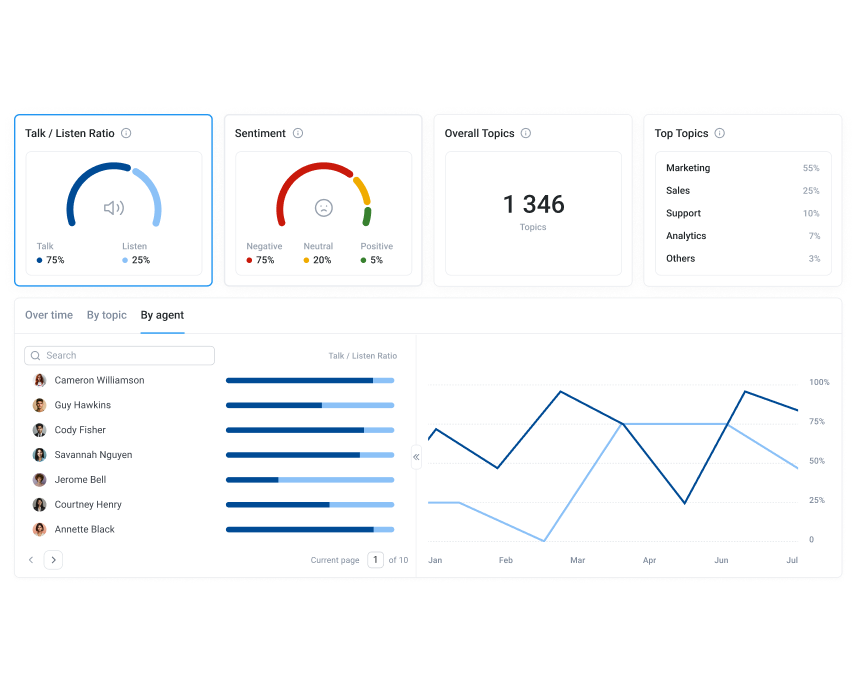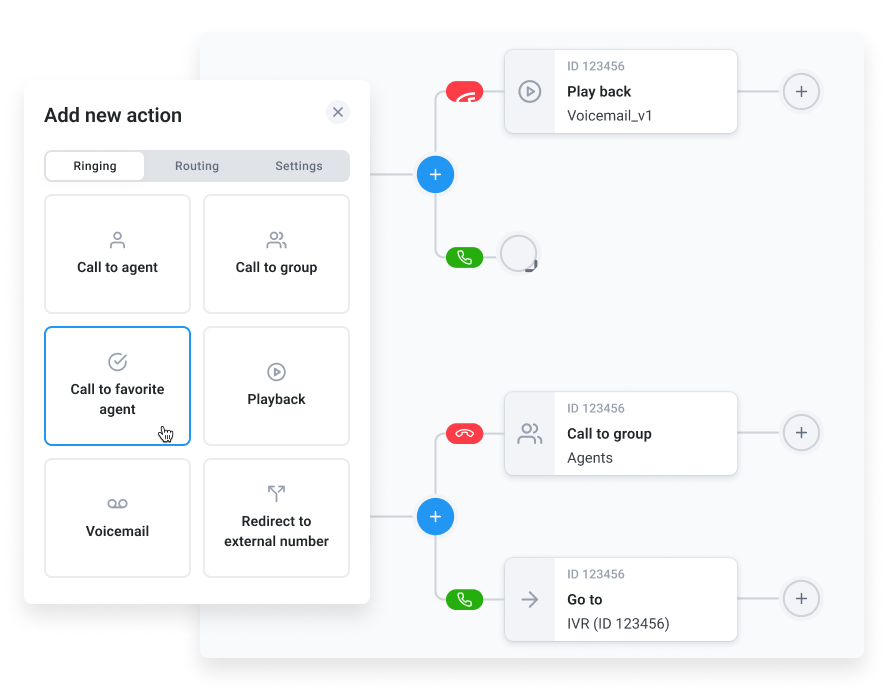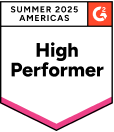
Call centers that use customer analytics outperform their peers by 126% in profits¹. But here’s the catch: bad data—or bad analysis—can do the exact opposite, driving up costs, lowering sales, and tanking customer satisfaction.
That’s why knowing how to analyze call center data isn’t optional. With so many metrics flying around, it’s easy to waste time tracking what doesn’t matter. The key is understanding which insights actually drive performance—and having the right tools and best practices to act on them.
Key Takeaways:
- Call centers using analytics see 126% higher profits—but only if the data is accurate and actionable.
- Real-time call center analytics let you monitor, adapt, and improve performance instantly by coaching reps in the moment.
- Focusing on the right metrics (like FCR, handle time, and sentiment) is the fastest way to boost efficiency without burning out your team.
See how AI-powered call analysis can boost performance and close more deals.
What is Call Center Analytics?
Call center analytics involves collecting, interpreting, and acting on data generated across your contact center. By analyzing this data—everything from agent performance and call volumes to customer satisfaction and service levels—teams can uncover what’s working, what’s not, and where to optimize.
It’s not just about tracking KPIs like average handle time or call volume. Call center data analysis digs deeper into the why behind the numbers, like identifying repeated call topics, spotting trends in customer sentiment, or flagging agents who may need extra support. By shedding light on these patterns, it helps you predict potential issues before they escalate and make targeted improvements to both agent performance and customer experience.
Today’s omnichannel contact centers connect customer touchpoints across calls, emails, chat, and social media. With the right tools like intelligent call routing and sentiment analysis, you can unify this contact center data to optimize staffing, improve routing, and deliver a smoother journey across every channel.
Effective call center business intelligence software doesn’t just make reporting easier—it fuels real-time decisions that improve performance, drive revenue, and boost customer loyalty.
Want to know how to improve call center performance with data-driven insights? Keep reading—we’ll break it all down.
Improve agent performance and close more deals.
How to Turn Call Center Data into Action: 7 Best Practices for Smarter Analysis
Collecting contact center data is easy. Knowing what to do with it? That’s where the real value lies. Whether you’re chasing higher efficiency, sharper coaching, or better customer outcomes, the secret is in how you analyze your data.
Below are 7 call center analytics best practices that combine proven strategies with powerful features like AI call scoring, real-time sentiment analysis, and speech-to-text transcription—to help you move from raw data to real impact.
1. Use Conversation Intelligence to Automate QA
Manually reviewing calls? That’s way too much time down the drain. With conversation intelligence tools like CloudTalk’s AI-powered call summaries, you can automatically transcribe, score, and evaluate every call—freeing up managers for strategic coaching.
AI call scoring surfaces trends across thousands of interactions, helping you identify which calls need attention and which agents are consistently excelling.
2. Leverage Sentiment Analysis to Detect Friction in Real-Time
Real-time sentiment analysis lets you understand how customers feel during a call—before they hang up. If frustration spikes or tone shifts, supervisors can step in or trigger automated workflows to de-escalate situations immediately.
3. Coach Agents Using Data-Backed Insights
Gut instinct isn’t a coaching strategy. Use data-backed performance dashboards to track talk time, hold time, first call resolution (FCR), and more.
Then schedule targeted feedback sessions based on trends—not hunches. Need a place to start? Check out our guide on how to improve call center agent performance.

4. Analyze First Call Resolution Trends to Identify Training Needs
If FCR is low, agents might need better resources or clearer workflows. Dig into call transcripts and QA scores to understand what’s going wrong—and which issues lead to repeat calls.
Improving FCR boosts both efficiency and customer satisfaction, making it a key driver for success in call center data analysis.
5. Visualize Call Journeys to Spot Workflow Bottlenecks
Use visual dashboards to map every step of the customer’s call experience, from IVR selections to agent transfers to resolution or drop-off. These visual call flows make it easy to pinpoint exactly where issues occur, like frequent transfers between departments, long hold times after specific menu options, or high abandonment rates at certain stages.
Once identified, these pain points can often be resolved with more intuitive IVR design, better call routing, or smarter agent scripts that guide conversations more efficiently.

6. Optimize Call Routing Based on Historical Patterns
Don’t leave call routing to chance. Use historical data to match incoming calls with the most skilled available agent—based on past resolutions, sentiment trends, and issue types.
Routing smarter = shorter handle times, higher FCR, and better CX.
7. Track and Reduce Silent Time in Customer Calls
Silence in a call with a customer is a serious red flag indicating agent confusion, slow systems, or unclear workflows. Monitor silent time using speech-to-text transcripts and AI-powered call scoring to understand where conversations stall.
Find out what’s going wrong in calls and how to improve them with call center data analysis.
6 Key Reasons to Analyze Call Center Data
Analyzing your call center data has real impacts on customer loyalty, team productivity, and your bottom line. Below are six key reasons why smart call center analytics is essential to every high-performing contact center.
1. Gain Deep Insights Into Customer Behavior
Every interaction tells a story. Analyzing call transcripts, sentiment trends, and conversation outcomes helps you understand customer needs, frustrations, and expectations at a granular level.
With tools like speech-to-text and sentiment analysis, you can decode what customers really think—no surveys required.
2. Reduce Operational Costs
Call center data shows you exactly where money is leaking—whether through long handle times, inefficient routing, or overstaffing during quiet hours.
Use historical insights to streamline operations, automate repetitive tasks, and trim expenses without compromising service quality.
3. Improve First Call Resolution (FCR) Rates
When customers have to call back multiple times to solve the same issue, it drains resources and damages trust. Low FCR not only frustrates customers and increases call volume, clogs up queues, and puts extra pressure on your team.
By analyzing FCR trends and spotting recurring blockers (like unclear scripts or missing knowledge base articles), you can equip agents to handle issues more effectively the first time. That means fewer repeat calls, happier customers, and a more efficient call center overall.
4. Enhance Agent Productivity and Coaching
Call center analytics gives team leads the visibility to coach smarter—not harder. With AI call scoring, you can pinpoint where agents need support, celebrate high performers, and align coaching with actual performance data.
5. Uncover Customer Pain Points and Journey Gaps
By mapping the entire omnichannel journey, you can find moments where customers get stuck, repeat themselves, or drop off entirely.
These gaps often reveal issues with self-service tools, routing, or communication consistency—and fixing them directly improves CX.
6. Enable Data-Driven Decision Making for Strategy Optimization
Call center business intelligence turns metrics into meaningful decisions by consolidating data across channels and highlighting actions you can take.
For example, it can reveal peak call times that inform smarter staffing schedules, or shine light on recurring customer complaints that point to product issues. Instead of relying on gut instinct, leaders can use real-time dashboards and historical trends to make informed decisions that improve efficiency, customer satisfaction, and overall strategy.
Get started analyzing your team’s calls the smart way.
7 Call Center Metrics That Matter Most
You don’t need all the data—just the right data. Here are the seven most important call center analytics metrics to track and why they matter:
- Call Volume Metrics: The total number of incoming and outgoing calls. Tracking this helps with staffing, forecasting, and identifying peak hours.
- Average Handle Time (AHT): The average time agents spend on a call, including hold and wrap-up time. AHT shows how efficiently agents resolve issues—but too low might signal rushed service.
- First Call Resolution (FCR): Measures how often customer issues are fully resolved in the first interaction. High FCR = less follow-up, happier customers, and better resource use.
- Customer Satisfaction Score (CSAT): A post-call survey score where customers rate their experience. CSAT offers a direct pulse on how your team is performing from the customer’s perspective.
- Net Promoter Score (NPS): Gauges customer loyalty by asking how likely they are to recommend your service. A strong NPS is linked to long-term retention and brand growth.
- Sentiment Analysis Results: AI-driven emotional analysis of customer conversations. It helps detect dissatisfaction early—even when customers don’t say it outright.
- Agent Performance Metrics: Includes talk time, resolution rate, QA scores, and more. Monitoring this ensures agents get the coaching they need to perform at their best.
What to Avoid When Analyzing Call Center Data
Even with the best tools, poor analysis can lead to wasted time—or worse, bad decisions. Here’s what to watch out for when working with your call center analytics:
- Focusing on vanity metrics like call volume alone: Call volume tells you how much is happening, not how well. Without tying it to outcomes like First Call Resolution (FCR) or CSAT, you’re just counting calls, not improving them.
- Ignoring Qualitative Data Like Customer Sentiment: Numbers can miss the emotional nuance. Sentiment analysis adds depth by showing how customers feel, not just what they say—crucial for identifying friction.
- Over-Analyzing Irrelevant Metrics: If a metric doesn’t tie directly to your goals—like reducing churn or boosting NPS—it’s noise. Stick to KPIs that drive real results.
- Not Aligning Metrics with Business KPIs: Your call center doesn’t exist in a vacuum. Align data analysis with broader business goals, like revenue growth or retention. Call center business intelligence helps bridge that gap.
- Using Data Without Context: Looking at isolated numbers (like long handle times) without knowing the customer’s history or issue complexity leads to bad calls and unfair evaluations.
- Failing to Clean and Validate Data Regularly: Outdated, duplicate, or incorrect data skews your analysis. Regular data hygiene ensures you’re making decisions based on facts—not flaws.
Get started analyzing your team’s calls the smart way.
Top 5 Call Center Analytics Software Tools
1. CloudTalk
Best for: SMBs and mid-market sales or support teams looking for robust analytics and global scalability.
CloudTalk offers a flexible, cloud-based phone system with Call Monitoring, AI call scoring, and Sentiment Analysis. Analytics provides powerful data visualization tools, allowing teams to track agent performance, spot inefficiencies, and boost CX.
CloudTalk offers four pricing plans, each with its own set of features:
- Lite (19/user/month]): Includes unlimited US & Canada calling, business SMS, International Numbers, Call Recording, basic call analytics, and 24/7 email/chat support.
- Essential (29/user/month): It offers 1,000 domestic outbound minutes, 24/7 live support, advanced analytics, IVR, Skill-Based routing, Integrations + Open API.
- Expert (49/user/month): It includes features like Power Dialer, Smart Dialer, VIP Queues, WhatsApp Inbound & Outbound Messages, and Call Monitoring.
- Custom (Varies): This plan is tailored for businesses with unique needs and includes custom onboarding, unlimited outbound calls with flat rates, enterprise-level security, and developer support.
2. Nextiva
Best for: Enterprises needing secure, omnichannel communication with HIPAA-compliant features.
Nextiva delivers workflow optimization, video conferencing, and mobile apps, with built-in analytics across channels. However, its limited integration stack (no Slack or Zapier) and higher pricing may not suit leaner teams.
Pricing: Starts at $30.95/user/month (Essential plan)
3. Dialpad
Best for: Sales teams prioritizing AI-powered speech analytics and sentiment tracking.
Dialpad includes speech-to-text, call recording, and voice intelligence features like live sentiment analysis. However, it lacks smart/predictive dialers and limits integration options outside Salesforce.
Pricing: Starts at $23/user/month (Standard plan)
4. RingCentral
Best for: Larger enterprises needing a full communications suite with strong uptime.
RingCentral supports SIP trunking, IVR, call routing, and video collaboration. It’s packed with features but key analytics like sentiment analysis and smart routing are locked behind its higher-tier Contact Center solution.
Pricing: Starts at $30/user/month (Core plan)
5. Five9
Best for: Mid-to-enterprise businesses seeking an all-in-one contact center solution.
Five9 offers omnichannel support, workforce optimization, and deep analytics across customer journeys. It’s ideal for complex environments but comes at a premium.
Pricing: Custom pricing (typically $100–$175/user/month depending on features).
Start getting actionable insights from your calls now.
Turn Your Call Center Data Into a Growth Engine
Your data is more than numbers—it’s your blueprint for better performance, happier customers, and faster decisions. The key? Analyze what matters, avoid the noise, and use the right tools to act on insights in real time.
That’s where CloudTalk comes in. With built-in analytics, real-time dashboards, and features like sentiment analysis, call tagging, and AI-powered insights, CloudTalk makes it easy to turn every conversation into actionable data. Whether you’re optimizing workflows, training agents, or uncovering customer trends, CloudTalk gives you the visibility and flexibility to make smarter, faster decisions.
Ready to unlock smarter call center analytics?
Sources:















